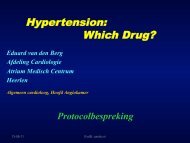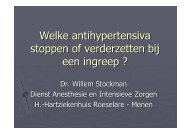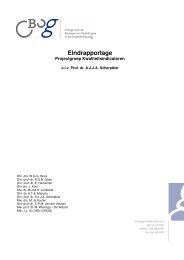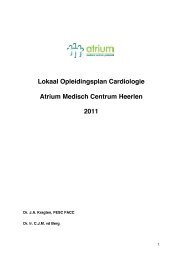Guidelines on the Management of Stable Angina Pectoris ... - Cardio
Guidelines on the Management of Stable Angina Pectoris ... - Cardio
Guidelines on the Management of Stable Angina Pectoris ... - Cardio
Create successful ePaper yourself
Turn your PDF publications into a flip-book with our unique Google optimized e-Paper software.
36 ESC <str<strong>on</strong>g>Guidelines</str<strong>on</strong>g>factors which are not modified by traditi<strong>on</strong>al anti-ischaemicagents.The TIBBS study 514 showed anti-ischaemic and anti-anginaleffects <strong>of</strong> both bisoprolol and nifedipine, but bisoprolol wasclearly more effective. The TIBET study compared <strong>the</strong>effects <strong>of</strong> atenolol, nifedipine, or <strong>the</strong>ir combinati<strong>on</strong> <strong>on</strong>exercise-induced ischaemia and <strong>the</strong> total ischaemic burdenin a double-blind, parallel group design. Both medicati<strong>on</strong>s,al<strong>on</strong>e and in combinati<strong>on</strong>, caused significant improvementsin exercise parameters and significant reducti<strong>on</strong>s in ischaemicactivity during daily activities when compared with placebobut <strong>the</strong>re were no significant differences between groupsfor any <strong>of</strong> <strong>the</strong> measured ischaemic parameters. There weresignificantly more withdrawals because <strong>of</strong> side-effects in<strong>the</strong> nifedipine group compared with <strong>the</strong> atenolol and <strong>the</strong>combinati<strong>on</strong> groups. 48,515 Meta-analyses comparing effects<strong>of</strong> beta-blockers and CCBs in stable angina pectoris indicatethat beta-blockers are more effective than CCBs in reducinganginal episodes, 494 but that effects <strong>on</strong> exercise toleranceand ischaemia <strong>of</strong> <strong>the</strong> two drug classes are similar. 157,494Thus, in <strong>the</strong> absence <strong>of</strong> prior MI, <strong>the</strong> available datasuggest that <strong>the</strong> choice between a beta-blocker and a CCBfor anti-anginal treatment may be guided by individualtolerance and <strong>the</strong> presence <strong>of</strong> o<strong>the</strong>r disease andco-treatment. If <strong>the</strong>se factors are equally weighted, abeta-blocker is recommended as <strong>the</strong> first choice.Comparis<strong>on</strong> <strong>of</strong> nitrates with beta-blockers or CCBs. Thereare relatively few studies comparing anti-anginal and antiischaemiceffects <strong>of</strong> l<strong>on</strong>g-acting nitrates with beta-blockersor CCBs, and <strong>the</strong>re is no documentati<strong>on</strong> c<strong>on</strong>cerning possibleeffects <strong>of</strong> nitrates <strong>on</strong> morbidity in stable angina pectoris. 494There were n<strong>on</strong>-significant trend towards less nitroglycerinuse with beta-blockers, and fewer angina episodes perweek with CCBs compared with l<strong>on</strong>g-acting nitrates in <strong>the</strong>meta-analysis by Heidenreich et al. 494 Thus l<strong>on</strong>g-actingnitrates have no overall <strong>the</strong>rapeutic advantages over betablockersor CCBs.Potassium channel openers. The principal agent in this class,nicorandil, has a dual mechanism <strong>of</strong> acti<strong>on</strong>, and is a potassiumchannel activator with a nitrate moiety and nitrate likeeffects. 516 Nicorandil is administered at a usual dose <strong>of</strong>20 mg bid for <strong>the</strong> preventi<strong>on</strong> <strong>of</strong> angina. Tolerance to <strong>the</strong>anti-anginal effect may develop with chr<strong>on</strong>ic dosing, 517but cross-tolerance with nitrates does not seem to be aproblem. 516 In additi<strong>on</strong> to its anti-anginal properties,nicorandil is thought to have cardioprotective properties.516,518 The Impact Of Nicorandil in <strong>Angina</strong> (IONA) trialshowed a significant reducti<strong>on</strong> <strong>of</strong> major cor<strong>on</strong>ary events instable angina patients treated with nicorandil comparedwith placebo as add-<strong>on</strong> to c<strong>on</strong>venti<strong>on</strong>al <strong>the</strong>rapy. 254However, <strong>the</strong> result was driven by effects <strong>of</strong> nicorandil <strong>on</strong>‘hospital admissi<strong>on</strong> for cardiac chest pain’, and <strong>the</strong> riskreducti<strong>on</strong> regarding cardiac death or n<strong>on</strong>-fatal MI during1.6 years <strong>of</strong> treatment was n<strong>on</strong>-significant; 254 thus <strong>the</strong>value <strong>of</strong> <strong>the</strong> treatment effect has been argued. 518Nicorandil is not available in all countries.O<strong>the</strong>r agents. Sinus node inhibitors, such as ivabradine, actby selectivity inhibiting <strong>the</strong> cardiac pacemaker current I f,and have negative chr<strong>on</strong>otropic effects both at rest andduring exercise. I f inhibiti<strong>on</strong> has proven anti-anginal efficacy461,519,520 and ivabradine may be used as an alternativeagent in patients who do not tolerate beta-blockade. It hasbeen licenced by <strong>the</strong> EMEA for this purpose.Metabolically acting agents protect from ischaemia byincreasing glucose metabolism relative to that <strong>of</strong> fattyacids. Trimetazidine and ranolazine are both c<strong>on</strong>sidered asmetabolic anti-anginal drugs. However, ranolazine has alsomore recently been shown to be an inhibitor <strong>of</strong> <strong>the</strong> latesodium current, 521 which is activated in case <strong>of</strong> ischaemia,leading to calcium overload <strong>of</strong> <strong>the</strong> ischaemic myocardium,decreased compliance, increased LV stiffness, and compressi<strong>on</strong><strong>of</strong> <strong>the</strong> capillaries. The inhibiti<strong>on</strong> <strong>of</strong> <strong>the</strong> latesodium current by ranolazine reverses <strong>the</strong>se effects, andprevents calcium overload, and <strong>the</strong> subsequent c<strong>on</strong>sequences<strong>the</strong>re<strong>of</strong>. 522,523Both trimetazidine 524–526 and ranolazine 527,528 have beenshown to have anti-anginal efficacy. They may be used incombinati<strong>on</strong> <strong>the</strong>rapy with haemodynamically actingagents, as <strong>the</strong>ir primary effect is not through reducti<strong>on</strong> inheart rate or blood pressure. Trimetazidine has been availablefor several years, but not in all countries. Ranolazine,although under intensive investigati<strong>on</strong> is not yet licencedfor use by <strong>the</strong> EMEA. Whe<strong>the</strong>r <strong>the</strong>se drugs influence <strong>the</strong>prognosis <strong>of</strong> patients with stable angina has not beendetermined.Molsidomine is a vasodilator with an acti<strong>on</strong> similar to that<strong>of</strong> organic nitrates and in <strong>the</strong> appropriate dosage is aneffective anti-ischaemic and anti-anginal agent. 529 It is notavailable in all countries.Recommendati<strong>on</strong>s for pharmacological <strong>the</strong>rapy. Antianginaldrug treatment should be tailored to <strong>the</strong> needs <strong>of</strong><strong>the</strong> individual patient, and should be m<strong>on</strong>itored individually.Short-acting nitrate <strong>the</strong>rapy should be prescribed for allpatients for immediate relief <strong>of</strong> acute symptoms as tolerated.Although different types <strong>of</strong> drugs have been shownto have additive anti-anginal effects in clinical trials, thismay not necessarily be so in <strong>the</strong> individual patient. Moreintense anti-anginal treatment may also cause problems,as it has been shown that three anti-anginal drugs mayprovide less symptomatic protecti<strong>on</strong> than two drugs. 530,531Thus, <strong>the</strong> dosing <strong>of</strong> <strong>on</strong>e drug should be optimized beforeadding ano<strong>the</strong>r <strong>on</strong>e, and it is advisable to switch drug combinati<strong>on</strong>sbefore attempting a three drug regimen. Pooradherence is always a factor to c<strong>on</strong>sider when drug<strong>the</strong>rapy is unsuccessful.An algorithm depicting <strong>the</strong> strategy for medical management<strong>of</strong> stable angina, if revascularizati<strong>on</strong> is not c<strong>on</strong>siderednecessary after initial evaluati<strong>on</strong> and risk stratificati<strong>on</strong>,includes treatments aimed at improving prognosis and symptomsand is shown in Figure 7. The following recommendati<strong>on</strong>spertain to anti-anginal <strong>the</strong>rapy and <strong>the</strong> level <strong>of</strong>evidence refers to anti-anginal or anti-ischaemic efficacyunless stated o<strong>the</strong>rwise.Recommendati<strong>on</strong>s for pharmacological <strong>the</strong>rapy toimprove symptoms and/or reduce ischaemia in patientswith stable anginaClass I(1) Provide short-acting nitroglycerin for acute symptomrelief and situati<strong>on</strong>al prophylaxis, with appropriateinstructi<strong>on</strong>s <strong>on</strong> how to use <strong>the</strong> treatment (level <strong>of</strong>evidence B)














